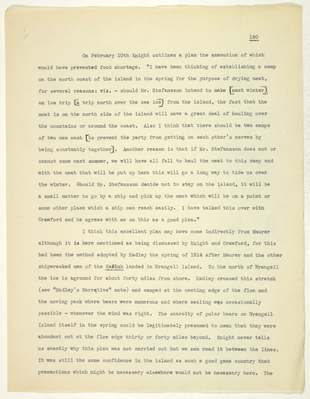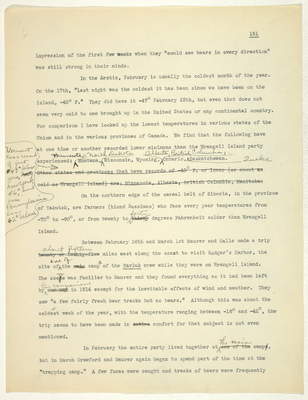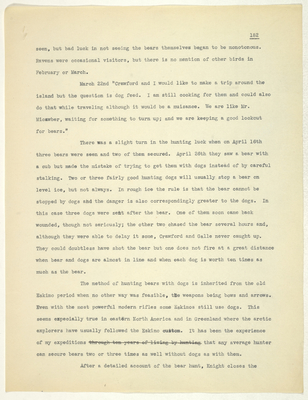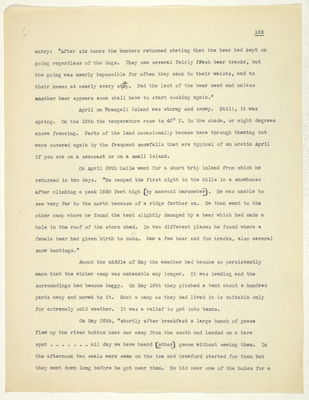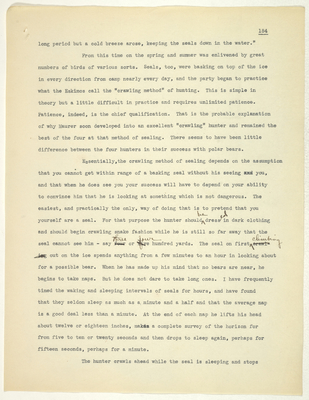Pages
stefansson-wrangel-09-29-031
180
On February 10th Knight outlines a plan the execution of which would have prevented food shortage. "I have been thinking of establishing a camp on the north coast of the island in the spring for the purpose of drying meat, for several reasons: viz. - should Mr. Stefansson intend to make [next winter] an ice trip [a trip north over the sea ice] from the island, the fact that the meat is on the north side of the island will save a great deal of hauling over the mountains or around the coast. Also I think that there should be two camps of two men each [to prevent the party from getting on each other's nerves by being constantly together]. Another reason is that if Mr. Stefansson does not or cannot come next summer, we will have all fall to haul the meat to this camp and with the meat that will be put up here this will go a long way to tide us over the winter. Should Mr. Stefansson decide not to stay on the island, it will be a small matter to go by a ship and pick up the meat which will be on a point or some other place which a ship can reach easily. I have talked this over with Crawford and he agrees with me on this as a good plan."
I think this excellent plan may have come indirectly from Maurer although it is here mentioned as being discussed by Knight and Crawford, for this had been the method adopted by Hadley the spring of 1914 after Maurer and the other shipwrecked men of the Karluk landed in Wrangell Island. To the north of Wrangell the ice is aground for about forty miles from shore. Hadley crossed this stretch (see "Hadley's Narrative" ante) and camped at the meeting edge of the floe and the moving pack where bears were numerous and where sealing was occasionally possible - whenever the wind was right. The scarcity of polar bears on Wrangell Island itself in the spring could be legitimately presumed to mean that they were abundant out at the floe edge thirty or forty miles beyond. Knight never tells us exactly why this plan was not carried out but we can read it between the lines. It was still the same confidence in the island as such a good game country that precautions which might be necessary elsewhere would not be necessary here. The
stefansson-wrangel-09-29-032
181
impression of the first few weeks when they “could see bears in every direction” was still strong in their minds.
In the Arctic, February is usually the coldest month of the year. On the 17th, "Last night was the coldest it has been since we have been on the island, -40° F." They did have it -47° February 25th, but even that does not seem very cold to one brought up in the United States or any continental country. For comparison I have looked up the lowest temperatures in various states of the Union and in the various provinces of Canada. We find that the following have at one time or another recorded lower minimums than the Warngell Island party experienced: Minnesota, Montana, North Dakota, Wisconsin, Wyoming, Alberta, British Columbia, Ontario, Quebec, Saskatchewan. Vermont has a record of just 47° below zero, New York 46°, and Pennsylvania 42° below. Other states and provinces that have records of -40° F. or lower (or about as cold as Wrangell Island) are: Minnesota, Alberta, British Columbia, Manitoba.
On the northern edge of the cereal belt of Siberia, in the province of Yakutsk, are farmers (blond Russians) who face every year temperatures from -70° to -90°, or from twenty to forty thirty degrees Fahrenheit colder than Wrangell Island.
Between February 26th and March 1st Maurer and Galle made a trip about fifteen twenty or twenty-five miles east along the coast to visit Rodger's Harbor, the site of one of the main camps of the Karluk crew while they were on Wrangell Island. The scene was familiar to Maurer and they found everything as it had been left by his companions our men in 1914 except for the inevitable effects of wind and weather. They saw "a few fairly fresh bear tracks but no bears." Althought this was about the coldest week of the year, with the temperature ranging between -16° and -42°, the trip seems to have been made in entire comfort for that subject is not even mentioned. In February the entire party lived together at the main one of the camps, but March Crawford and Maurer again began to spend part of the time at the "trapping camp." A few foxes were caught and tracks of bears were frequently
stefansson-wrangel-09-29-033
182
seen, but bad luck in not seeing the bears themselves began to be monotonous. Ravens were occasional visitors, but there is no mention of other birds in February or March.
March 22nd "Crawford and I would like to make a trip around the island but the question is dog feed. I am still cooking for them and could also do that while traveling although it would be a nuisance. We are like Mr. Micawber, waiting for something to turn up; and we are keeping a good lookout for bears."
There was a slight turn in the hunting luck when on April 16th three bears were seen and two of them secured. April 26th they saw a bear with a cub but made the mistake of trying to get them with dogs instead of by careful stalking. Two or three fairly good hunting dogs will usually stop a bear on level ice, but not always. In rough ice the rule is that the bear cannot be stopped by dogs and the danger is also correspondingly greater to the dogs. In this case three dogs were sent after the bear. One of them soon came back wounded, though not seriously; the other two chased the bear several hours and, although they were able to delay it some, Crawford and Galle never caught up. They could doubtless have shot the bear but one does not fire at a great distance when bear and dogs are almost in line and when each dog is worth ten times as much as the bear.
The method of hunting bears with dogs is inherited from the old Eskimo period when no other way was feasible, the weapons being bows and arrows. Even with the most powerful modern rifles some Eskimos still use dogs. This seems especially true in eastern North America and in Greenland where the arctic explorers have usually followed the Eskimo custom. It has been the experience of my expeditions through ten years of living by hunting that any average hunter can secure bears two or three times as well without dogs as with them.
After a detailed account of the bear hunt, Knight closes the
stefansson-wrangel-09-29-034
183
entry: “After six hours the hunters returned stating that the bear had kept on going regardless of the dogs. They saw several fairly fresh bear tracks, but the going was nearly impossible for often they sank to their waists, and to their knees at nearly every stoep. Fed the last of the bear meat and unless another bear appears soon shall have to start cooking again."
April on Wrangell Island was stormy and snowy. Still, it was spring. On the 28th the temperature rose to 40° F. in the shade, or eight degrees above freezing. Parts of the land occasionally became bare through thawing but were covered again by the frequent snowfalls that are typical of an arctic April if you are on a seacoast or on a small island.
On April 29th Galle went for a short trip inland from which he returned in two days. "He camped the first night in the hills in a snowhouse after climbing a peak 1950 feet high [by aneroid barometer]. He was unable to see very far to the north because of a ridge farther on. He then went to the other camp where he found the tent slightly damaged by a bear which had made a hole in the roof of the storm shed. In two different places he found where a female bear had given birth to cubs. Saw a few bear and fox tracks, also several snow buntings."
About the middle of May the weather had become so persistently warm that the winter camp was untenable any longer. It was leaking and the surroundings had become boggy. On May 18th they pitched a tent about a hundred yards away and moved to it. Such a camp as they had lived in is suitable only for extremely cold weather. It was a relief to get into tents.
On May 25th, "shortly after breakfast a large bunch of geese flew up the river bottom near our camp from the south and landed on a bare spot............. all day we have heard [other] geese without seeing them. In the afternoon two seals were seen on the ice and Crawford started for them but they went down long before he got near them. He hid near one of the holes for a
stefansson-wrangel-09-29-035
184
long period but a cold breeze arose, keeping the seals down in the water."
From this time on the spring and summer was enlivened by great numbers of birds of various sorts. Seals, too, were basking on top of the ice in every direction from camp nearly every day, and the party began to practice what the Eskimos call the "crawling method" of hunting. This is simple in theory but a little difficult in practice and requires unlimited patience. Patience, indeed, is the chief qualification. That is the probable explanation of why Maurer soon developed into an excellent "crawling" hunter and remained the best of the four at that method of sealing. There seems to have been little difference between the four hunters in their success with polar bears.
Essentially,the crawling method of sealing depends on the assumption that you cannot get within range of a basking seal without his seeing [xxx] you, and that when he does see you your success will have to depend on your ability to convince him that he is looking at something which is not dangerous. The easiest, and practically the only, way of doing that is to pretend that you yourself are a seal. For that purpose the hunter should be dressed in dark clothing and should begin crawling snake fashion while he is still so far away that the seal cannot see him - say three four or four five hundred yards. The seal on first climbing crawling out on the ice spends anything from a few minutes to an hour in looking about for a possible bear. When he has made up his mind that no bears are near, he begins to take naps. But he does not dare to take long ones. I have frequently timed the waking and sleeping intervals of seals for hours, and have found that they seldom sleep as much as a, minute and a half and that the average nap is a good deal less than a minute. At the end of each nap he lifts his head about twelve or eighteen inches, makes a complete survey of the horizon for from five to ten or twenty seconds and then drops to sleep again, perhaps for fifteen seconds, perhaps for a minute.
The hunter crawls ahead while the seal is sleeping and stops
